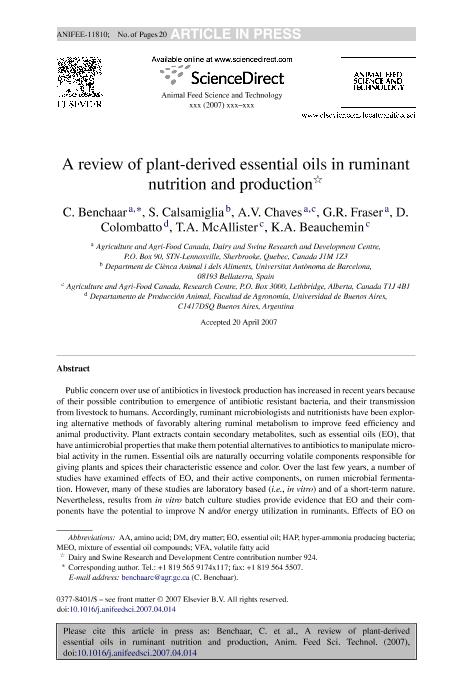Mostrar el registro sencillo del ítem
dc.contributor.author
Benchaar, Chaouki
dc.contributor.author
Calsamiglia, Sergio B.

dc.contributor.author
Chaves, Alexandre V.

dc.contributor.author
Fraser, G. R.
dc.contributor.author
Colombatto, Dario

dc.contributor.author
McAllister, Tim A.

dc.contributor.author
Beauchemin, Karen Anne
dc.date.available
2021-04-21T01:20:48Z
dc.date.issued
2008-08
dc.identifier.citation
Benchaar, Chaouki; Calsamiglia, Sergio B.; Chaves, Alexandre V.; Fraser, G. R.; Colombatto, Dario; et al.; A review of plant-derived essential oils in ruminant nutrition and production; Elsevier Science; Animal Feed Science and Technology; 145; 1-4; 8-2008; 209-228
dc.identifier.issn
0377-8401
dc.identifier.uri
http://hdl.handle.net/11336/130553
dc.description.abstract
Public concern over use of antibiotics in livestock production has increased in recent years because of their possible contribution to emergence of antibiotic resistant bacteria, and their transmission from livestock to humans. Accordingly, ruminant microbiologists and nutritionists have been exploring alternative methods of favorably altering ruminal metabolism to improve feed efficiency and animal productivity. Plant extracts contain secondary metabolites, such as essential oils (EO), that have antimicrobial properties that make them potential alternatives to antibiotics to manipulate microbial activity in the rumen. Essential oils are naturally occurring volatile components responsible for giving plants and spices their characteristic essence and color. Over the last few years, a number of studies have examined effects of EO, and their active components, on rumen microbial fermentation. However, many of these studies are laboratory based (i.e., in vitro) and of a short-term nature. Nevertheless, results from in vitro batch culture studies provide evidence that EO and their components have the potential to improve N and/or energy utilization in ruminants. Effects of EO on ruminal N metabolism is more likely mediated by their impact on hyper-ammonia producing (HAP) bacteria resulting in reduced deamination of amino acids (AA) and production of ammonia N. However, these responses are only observed with high doses of EO, which also can inhibit the process of ruminal fermentation as reflected by a decline in total volatile fatty acid production. Effects on methane production are inconsistent, but evidence to date indicates that there is potential to select EO, or active components, that selectively inhibit ruminal methanogenesis. Results from in vitro continuous culture studies suggest that rumen microbial populations may adapt to EO, which may explain the lack of an effect of EO on ruminal metabolism and animal performance in long-term in vivo studies. Several studies have examined the activity of a number of EO against a wide variety of food-borne pathogens. Data available show a strong bactericidal activity against pathogenic bacteria such as Escherichia coli O157:H7 and Salmonella spp. Essential oils hold promise as feed additives in ruminant nutrition to improve feed efficiency and control the spread of pathogens in livestock. However identification of EO, or their active components, that favorably alter fermentation without resulting in broad overall inhibition of rumen fermentation, continues to be a major challenge for researchers. © 2007 Elsevier B.V. All rights reserved.
dc.format
application/pdf
dc.language.iso
eng
dc.publisher
Elsevier Science

dc.rights
info:eu-repo/semantics/openAccess
dc.rights.uri
https://creativecommons.org/licenses/by-nc-sa/2.5/ar/
dc.subject
CONTROL OF PATHOGENS
dc.subject
ESSENTIAL OIL
dc.subject
METABOLISM
dc.subject
PRODUCTION
dc.subject
RUMINANT
dc.subject.classification
Ciencias Veterinarias

dc.subject.classification
Ciencias Veterinarias

dc.subject.classification
CIENCIAS AGRÍCOLAS

dc.title
A review of plant-derived essential oils in ruminant nutrition and production
dc.type
info:eu-repo/semantics/article
dc.type
info:ar-repo/semantics/artículo
dc.type
info:eu-repo/semantics/publishedVersion
dc.date.updated
2021-04-19T14:24:00Z
dc.journal.volume
145
dc.journal.number
1-4
dc.journal.pagination
209-228
dc.journal.pais
Países Bajos

dc.journal.ciudad
Amsterdam
dc.description.fil
Fil: Benchaar, Chaouki. Agriculture and Agri-Food Canada; Canadá
dc.description.fil
Fil: Calsamiglia, Sergio B.. Universitat Autònoma de Barcelona; España
dc.description.fil
Fil: Chaves, Alexandre V.. Agriculture and Agri-Food Canada; Canadá
dc.description.fil
Fil: Fraser, G. R.. Agriculture and Agri-Food Canada; Canadá
dc.description.fil
Fil: Colombatto, Dario. Universidad de Buenos Aires. Facultad de Ciencias Veterinarias. Instituto de Investigacion y Tecnología en Reproducción Animal; Argentina. Consejo Nacional de Investigaciones Científicas y Técnicas; Argentina
dc.description.fil
Fil: McAllister, Tim A.. Agriculture and Agri-Food Canada; Canadá
dc.description.fil
Fil: Beauchemin, Karen Anne. Agriculture and Agri-Food Canada; Canadá
dc.journal.title
Animal Feed Science and Technology

dc.relation.alternativeid
info:eu-repo/semantics/altIdentifier/url/https://www.sciencedirect.com/science/article/pii/S0377840107002751
dc.relation.alternativeid
info:eu-repo/semantics/altIdentifier/doi/http://dx.doi.org/10.1016/j.anifeedsci.2007.04.014
Archivos asociados
